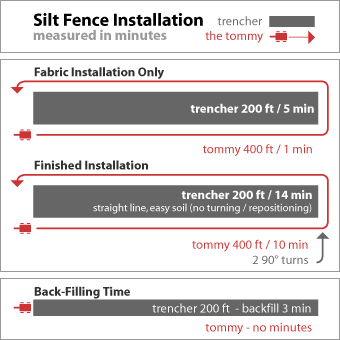Trencher vs tommy™
Eliminating all of the manual labor involved with installing fabric in the soil cuts in half the time and effort normally involved. Minimizing the volume of materials to be man-handled also improves efficiency. These factors all improve the morale of the crew, which has significant benefits to management and customers.
In simultaneous, apples to apples races between the tommy™ and the different types of trenchers, the tommy™ literally ran a circle around them while installing 400 feet of fabric in less time than the trenchers installed 200 feet in an easy, straight run.

The tommy™ installed 400 feet of finished fence in 10 minutes, with only a two-man crew. That computes to 1200 feet per man-hour. The best trencher installation was 200 feet in 12 minutes, or 500 feet per man-hour, with trenching more than 50% slower than slicing.
A person might argue that the trencher is more efficient with more laborers––that more laborers inherently make the trenching operation efficient. But it's not true. It just takes a lot of time to excavate tons of soil, man-handle a multitude of bulky material, and then backfill properly, which doesn't even account for many conditions where the trencher can't manuever or operate.
- who wants to hire more laborers and their related problems when they can use a machine
- an extra man would make the tommy™ even more efficient––significantly more so than one would to a trencher


